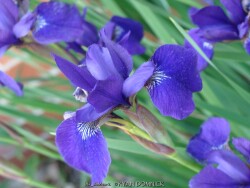

***Description for this perennial available with future update!***>>>>>This plant can also be used as a marginal aquatic plant growing in shallow water. It can also grow as a bog plant needing constantly moist soil rich in organic matter. As a rain garden plant, it will thrive is a depressed area in the landscape that collects rain water from a roof during spring and summer periods of rain but then go dormant if the water hole dries out completely.
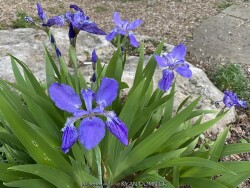

Japanese Roof Iris (Iris tectorum) is a rhizomatous perennial iris species with attractive clusters of wide fan-like foliage. It is native of China and Korea, with lavender-blue, bluish-violet, purple-blue, blue-lilac or sky blue flowers. Although flowers are attractive, this plant is grown just as much for its foliage. It prefers to grow in rich, well-drained, forest soil in part shade. This plant will grow in thin soils on top of rock outcroppings provided that moisture is available; Iris tectorum is commonly called 'roof iris' because it was grown in the thatch of Chinese and Japanese houses. Mostly used in Kansas gardens as an accent or curiosity plant.
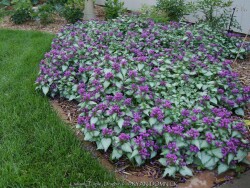

***Description for this perennial available with future update!***>>>>>Ultra cold-hardy plants from northern climates normally dislike our long hot humid summers; although we are on the Southern edge of this plants adaptability, it still survives reasonably well here. Look for a cold microclimate planting location such as East or North exposure.>>>>>
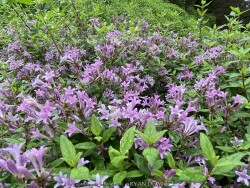

***Shrub descriptions available with future update!***Purple Flowering Leptodermis, is also known as Leptodermis oblonga
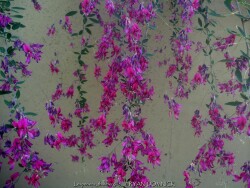

***Shrub descriptions available with future update!***Gibraltar Bush Clover, is also known as Lespedeza thunbergii 'Gibraltar'
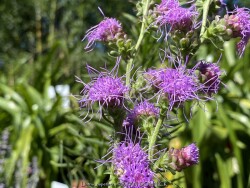

***Description for this perennial available with future update!*** >>>>> Blooms later (late summer to fall) than most other Liatris species. This species is distinguished from other Liatris species by its rough appearance and rounded individual flower clusters. Good winter drainage is important.
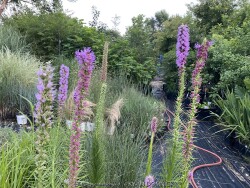

***Description for this perennial available with future update!***Prairie Blazing Star / Liatris, is also known as Liatris pycnostachya


***Description for this perennial available with future update!***Stargazer Garden Lily, is also known as Lilium 'Stargazer'
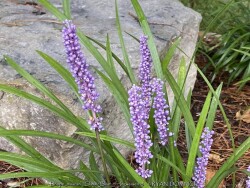

Royal Purple Liriope (Liriope muscari 'Royal Purple') grows to form a dense, dark green, grass-like groundcover in medium to full shade. As one of the very best "dry-shade" plants, it has environmental and economic traits that can help conserve water and lower your water bill! Plantings can thrive for decades if in the right spot; there is no such thing as overcrowding for Liriope. When planted in mass, growth is slow at first but eventually a cake-like rhizome system will form and completely smother out any weeds and compete well with trees for water and nutrients. Even under the most hostile conditions such as huge silver maple and pin oak trees, liriope not only survives but thrives. While Big Blue Liriope can tolerate full sun, they prefer part to full shade. Sun burning is possible with temperatures over 100° and there are better plants to use in hot areas. Liriope has no insect or disease problems, will survive droughts, short-term floods and cold winters. In the winter, it will stay green until 0 degrees F and be completely evergreen some winters. Liriope also thrives in summer with the worst heat and humidity even in the Southeast and Southwest! Liriope is tolerant of a wide range of soil types but prefers clay/loam and will display best growth in fertile soils with average water but extremely drought tolerant in shaded areas! For the home garden, the species spreads slowly so you shouldn't leave very much room in-between Liriope plants or you will be waiting many years for the patch to fill in. Weeds can be a problem in that open area between plants if spacing is too wide. We recommend 12-18" spacing for a larger area. The only problem we have seen is a mysterious crown-rot disease in well-irrigated gardens. This liriope (Liriope muscari 'Royal Purple') does not spread very quickly or much at all compared to Spreading Liriope / Monkey Grass (Liriope spicata) This is a real trooper for the dry shade garden!
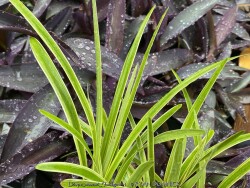

Variegated Liriope (Liriope muscari 'Variegata') grows to form a dense, dark green, grass-like groundcover in medium to full shade. As one of the very best "dry-shade" plants, it has environmental and economic traits that can help conserve water and lower your water bill! Plantings can thrive for decades if in the right spot; there is no such thing as overcrowding for Liriope. When planted in mass, growth is slow at first but eventually a cake-like rhizome system will form and completely smother out any weeds and compete well with trees for water and nutrients. Even under the most hostile conditions such as huge silver maple and pin oak trees, liriope not only survives but thrives. While Big Blue Liriope can tolerate full sun, they prefer part to full shade. Sun burning is possible with temperatures over 100° and there are better plants to use in hot areas. Liriope has no insect or disease problems, will survive droughts, short-term floods and cold winters. In the winter, it will stay green until 0 degrees F and be completely evergreen some winters. Liriope also thrives in summer with the worst heat and humidity even in the Southeast and Southwest! Liriope is tolerant of a wide range of soil types but prefers clay/loam and will display best growth in fertile soils with average water but extremely drought tolerant in shaded areas! For the home garden, the species spreads slowly so you shouldn't leave very much room in-between Liriope plants or you will be waiting many years for the patch to fill in. Weeds can be a problem in that open area between plants if spacing is too wide. We recommend 12-18" spacing for a larger area. The only problem we have seen is a mysterious crown-rot disease in well-irrigated gardens. This liriope (Liriope muscari 'Variegata') does not spread very quickly or much at all compared to Spreading Liriope / Monkey Grass (Liriope spicata) This is a real trooper for the dry shade garden!
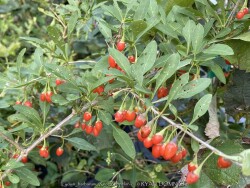

It's easy to grow your own goji berries! Though they seem like something exotic and tricky to grow, goji berries are durable, productive plants that can be grown without any special sprays, fertilizers, or even fussy pruning. Just plant them in full sun, stake them, and wait to reap a bounty of bright red fruits in autumn. Red Zeppelin® Goji Berry (Lycium barbarum 'Red Zeppelin') was selected especially for its very large fruit, which makes harvesting easier and more fun. A few things to note about growing goji berries: 1. they prefer an alkaline (higher pH) soil and don't grow well in acidic conditions. 2. goji has a natural habit of creating lots of thin, vine-like stems. To save space and make harvesting easier, we recommend that you put a very sturdy stake near the shrub after planting, then bundle the stems around the stake, tying with sturdy twine so that about one-quarter of the tops of the branches cascade downward, like a fountain. 3. Goji is generally a heavy feeder, and regular fertilizing is recommended. Apply a tomato or rose fertilizer in spring and again in early summer. The fruits are a bit bitter, like a green pepper, when they are fresh. To develop sweetness, they must be dried. If you don't have a dehydrator, spread ripe berries in a single layer on a piece of newspaper in a cool, bright spot with good air circulation. After about a week, they will feel leathery and can be stored in the fridge or freezer. Maintenance Notes: Does best in well-drained neutral to alkaline soils. At planting time, sink a 1x1" wood stake near the plant and bundle the canes around it. Let the tips of the stems cascade down, like a fountain. Each spring, move the tied point up further along the stake so that about one-quarter of the growth is above the tie. Then cut the branch tips back by 4-6". This encourages lateral branching, which is where most of the flowering and fruiting takes place. In Eastern Kansas, typically our 40 inches of rainfall is sufficient without extra water. All Proven Winners® plants are legally propagated, healthy and vigorous, true to name, and tagged with color pictures and growing information.
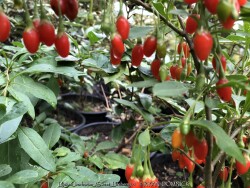

Gogi berries (Lycium barbarum) have purple flowers in mid-summer develop into jewel-like red fruits that are bitter and tomato-like when fresh but turn sweet when set out to dry for a week or so. Very high yielding, especially in alkaline soils. Sweet Lifeberry Gogi Berry (Lycium barbarum 'Sweet Lifeberry') was selected for its extra-sweet fruit which makes for easier harvesting. Maintenance Notes: Does best in well-drained neutral to slightly alkaline soils. At planting time, sink a 1x1" wood stake near the plant and bundle the canes around it. Let the tips of the stems cascade down, like a fountain. Each spring, move the tied point up further along the stake so that about one-quarter of the growth is above the tie. Then cut the branch tips back by 4-6". This encourages lateral branching, which is where most of the flowering and fruiting takes place. Grow superfruit in your own backyard! Fruits become especially sweet when dried. Goji berries are easy to grow in full sun, although some staking is recommended for maximum access to the nutrient-rich fruit. A pollinator is not needed. In Eastern Kansas, typically our 40 inches of rainfall is sufficient without extra water. All Proven Winners® plants are legally propagated, healthy and vigorous, true to name, and tagged with color pictures and growing information.
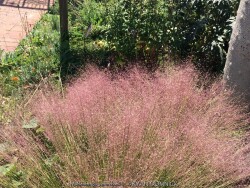

***Description for this grass available with future update!***Undaunted Ruby Muhly Grass, is also known as Muhlenbergia reverchonii ***Description for this plant available with future update!***
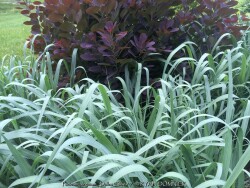

***Description for this grass available with future update!***Dallas Blues Switch Grass, is also known as Panicum virgatum 'Dallas Blues'
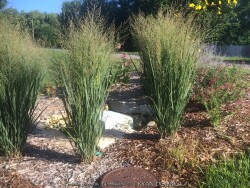

***Description for this grass available with future update!***Northwinds Switch Grass, is also known as Panicum virgatum 'Northwinds'
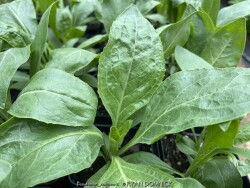

***Description for this perennial available with future update!***
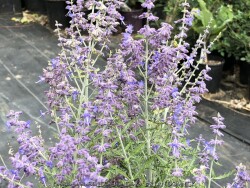

Russian sage (Perovskia atriplicifolia) is a perfectly well-adapted plant from Afghanistan, Pakistan, and Central Asia. It is the perfect match to hot Kansas summers, cold winters, rocky alkaline soils, and drought. Fine-textured foliage is upright and shrub-like consisting of a mint green to blush green color. Lavender to bluish flowers emerging in mid-summer are extremely long-lasting. In fall, Russian sage foliage dies back with the first hard freeze and becomes a whitish-gray color adding awesome winter interest. Imagine this combined with ornamental grasses or bright winter-colored plants like Color Guard Yucca. The only maintenance is cutting the plant back to you about 6 to 8 inches in the spring. New buds emerge from the root system and lower parts of the woody growth. New cultivars of Russian sage do not spread by rhizomes like the species. Russian sage thrives in dry well-drained soils with plenty of full sun and air circulation. They are suitable for hot west or south exposures, berms, parking lot islands, hell strips along roads, and other inhospitable locations. They tolerate poor soil including rock, sand, clay, and alkalinity. They do not tolerate poor drainage and will be floppy even in part shade. Russian sage flowers are highly attractive to honeybees. There are several improved cultivars with improved blooming, improved growth habit, and elimination of spreading. Blue Jean Baby Russian Sage (Perovskia atriplicifolia 'Blue Jean Baby') is a wonderful compact, non-spreading, and non-flopping variety. Lavender blue flowers held in smoky purple calyxes bloom for a long period starting in midsummer, with the color from the calyxes extending appeal into fall. Blue Jean Baby a Walters Gardens Inc. introduction.


Russian sage (Perovskia atriplicifolia) is a perfectly well-adapted plant from Afghanistan, Pakistan, and Central Asia. It is the perfect match to hot Kansas summers, cold winters, rocky alkaline soils, and drought. Fine-textured foliage is upright and shrub-like consisting of a mint green to blush green color. Lavender to bluish flowers emerging in mid-summer are extremely long-lasting. In fall, Russian sage foliage dies back with the first hard freeze and becomes a whitish-gray color adding awesome winter interest. Imagine this combined with ornamental grasses or bright winter-colored plants like Color Guard Yucca. The only maintenance is cutting the plant back to you about 6 to 8 inches in the spring. New buds emerge from the root system and lower parts of the woody growth. New cultivars of Russian sage do not spread by rhizomes like the species. Russian sage thrives in dry well-drained soils with plenty of full sun and air circulation. They are suitable for hot west or south exposures, berms, parking lot islands, hell strips along roads, and other inhospitable locations. They tolerate poor soil including rock, sand, clay, and alkalinity. They do not tolerate poor drainage and will be floppy even in part shade. Russian sage flowers are highly attractive to honeybees. There are several improved cultivars with improved blooming, improved growth habit, and elimination of spreading. "Tough as steel! A new seed introduction by PanAm Seed with a sturdy, controlled habit in the landscape. 'Blue Steel' combines the best summer-blooming lavender-blue colour with outstanding late-season garden performance and has aromatic, silvery foliage carrying clouds of small blue flowers on strong silver stems that do not break or split easily. It is very hardy and Heat/drought tolerant." - PanAm Seed
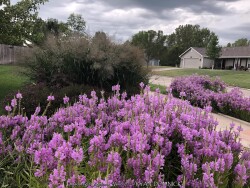

***Description for this perennial available with future update!***Vivid Purple Obedient Plant, is also known as Physostegia virginiana 'Vivid'
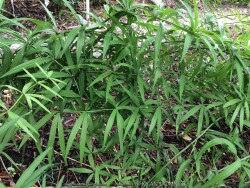

Solomon Seal (Polygonatum sp.) is a very large genus of perennials comprising dozens of species. Many of the species that are appropriate for garden use in Kansas are native to seasonally dry to moist forests in North America and Asia. Orange Flowering Climbing Solomon's Seal (Polygonatum kingianum / huanum) is definitely not typical of the genus! This plant has "climbed" above other Solomon seals! New vining growth several feet tall arises each year from a non-spreading rhizome. The foliage has a central stem with architecturally arranged opposite leaves covering the length of the stem gradually getting smaller towards the end. Two tiny hooks are located on the tips of each leaf, helping it to gently cling onto a structure or other plant for support. Elongated bell-shaped flowers appearing in spring are orange with green tips, yes ORANGE! This small "vine-like" plant is a curiosity and specimen plant. Grow in moist, well drained forest soil with average irrigation. This beauty can reach 12' tall but in our Kansas display garden, we are on year 3 (2021) with growth about 3' and increasing each year.


Blackberry (Rubus sp.) is an "easy to grow" edible fruit that is worth growing in Kansas. Store-bought blackberries are expensive and don't taste as good as garden grown fruits. All cultivars of blackberries have perennial roots, but most top shoots only live for two years. (meaning shoots grow in the first growing season and fruits grow on those shoots during the second growing season) The cycle is repeated; maintenance involves removing old canes after decline or death. Raspberries are vigorous and can be locally invasive in the garden but rarely invasive in the wild. They propagate by basal shoots (also known as suckers) spreading some distance from the main plant. After establishment, it is high maintenance if it has already filled the space and you don't want it to spread any further so plan accordingly. In the landscape, raspberry and blackberry mix well into garden designs with ornamental plants as long as you create it's own area (like a background fence to train plants on) The main difference between raspberry and blackberry are that the fruit releases from the raspberry differently. The "torus" or inside center of the fruit is hollow and releases from the stem with raspberry. With Blackberry, the "torus" or center "picks with" the fruit giving a solid fruit to eat. (just in case you have always wondered) Our supplier, Spring Meadows Nursery has this to say about this new PROVEN WINNERS plant: Taste of Heaven blackberry (Rubus 'Ponca') is the sweetest, most flavorful blackberry on the market - and now you can grow it at home. We know, that's a tall claim, but you don't need to take our word for it: this article in the journal HortScience confirms it. And we know because we tasted literally hundreds of different blackberry varieties before deciding this would be the one to make it on to further testing. Taste of Heaven is a vigorous, thornless blackberry that produces large, luscious fruits over several weeks in summer. It's a floricane variety, fruiting only on second-year canes, and does not strictly require trellising or support, though in the garden, it is easier to care for and harvest with something in place.
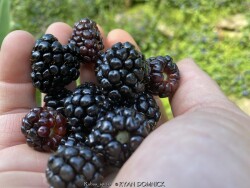

Blackberry (Rubus sp.) is an "easy to grow" edible fruit that is worth growing in Kansas. Store-bought blackberries are expensive and don't taste as good as garden grown fruits. All cultivars of blackberries have perennial roots, but most top shoots only live for two years. (meaning shoots grow in the first growing season and fruits grow on those shoots during the second growing season) The cycle is repeated; maintenance involves removing old canes after decline or death. Raspberries are vigorous and can be locally invasive in the garden but rarely invasive in the wild. They propagate by basal shoots (also known as suckers) spreading some distance from the main plant. After establishment, it is high maintenance if it has already filled the space and you don't want it to spread any further so plan accordingly. In the landscape, raspberry and blackberry mix well into garden designs with ornamental plants as long as you create it's own area (like a background fence to train plants on) The main difference between raspberry and blackberry are that the fruit releases from the raspberry differently. The "torus" or inside center of the fruit is hollow and releases from the stem with raspberry. With Blackberry, the "torus" or center "picks with" the fruit giving a solid fruit to eat. (just in case you have always wondered) Our supplier, Forrest Keeling nursery, has released an array of improved hybrids and varieties available.
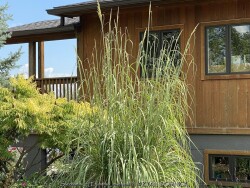

***Description for this grass available with future update!***Hardy Pampas Grass / Plume Grass, is also known as Saccharum / Erianthus ravennae
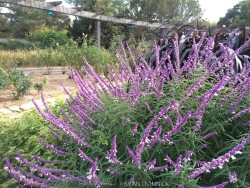

***Description for this plant available with future update!***
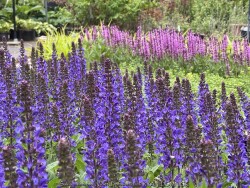

***Description for this perennial available with future update!***>>>>>Enjoy these flowers again and again throughout the summer with rebloom! Violet blue flowers are produced on rosy purple calyxes on a perfectly rounded, dense and beautiful habit.>>>>>>>>>All Proven Winners® plants are legally propagated, healthy and vigorous, true to name, and tagged with color pictures and growing information.
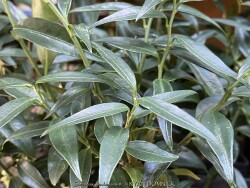

Himalayan Sweet Box (Sarcococca hookeriana) is planted for its evergreen dark green foliage and white flowers. Foliage maintains well all year provided that certain cultural conditions are met. Native to shaded mountain areas in forests, valleys or along streams in the Himalayas, it needs moist soil rich in organic matter avoiding too much clay. It is somewhat drought tolerant once established. If low temperatures hit -5 to -10 degrees F, foliage finally dies back to the ground and re-emerges in early spring. Generally this plant can decline after a few years of Kansas climate but is worth a try in perfect soils in well-tended shade gardens. If low temperatures hit -10 degrees F, it may kill an un-mulched plant; protect any zone 6 plant with thick layer of mulch. Lack of moisture and competition with weeds seem to be an issue but it survives just fine. Growth is extremely slow. This is one of the most deep shade tolerant plants available.
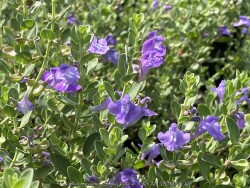

***Description for this perennial available with future update!***Smoky Hills Skullcap / Native Scutellaria, is also known as Scutellaria resinosa 'Smoky Hills'
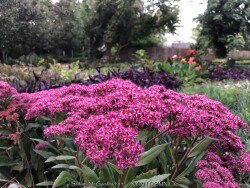

***Description for this perennial available with future update!***Mr.Goodbud / Carl Sedum, is also known as Sedum 'Mr.Goodbud / Carl'
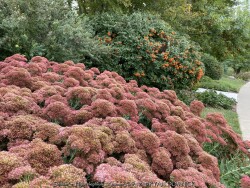

***Description for this perennial available with future update!***Autumn Fire Sedum, is also known as Sedum / Hylotelephium 'Autumn Fire'
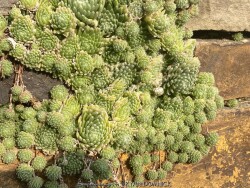

These tiny perennial succulents (Sempervivum sp.) produce various colored mats of foliage rosettes. In favorable conditions they can spread rapidly by offsets; several species are valued in cultivation as groundcover for dry, sunny locations. Hen & Chicks are native to alpine mountainous areas in native to southern Europe and northern Africa. Grow this small native gem in a rock garden, in cracks between rocks, or on top of or in a retaining wall. You may also grow in flat areas like in between stepping stones provided you used a gravelly or sandy base for the stones. It will not tolerate rich moist soils as other plants or weeds will shade it out. Crown rot can occur during lengthy hot humid summer rainy periods. Hen & Chicks do not thrive indoors; aphids and spider mites seem to find them after a few months but overwintering indoors in a cool environment may work. Plants with plenty of time to acclimate will thrive in full sun but be careful not to rush it or sunburning will occur. Generally if moving outside for the summer, allow 2-3 weeks of part shade or morning sun before placing in full sun. If grown in pots and kept on the dry side, you may leave out all winter allowing to freeze solid; plants will go dormant and resume growth in the spring. This is more successful than overwintering inside. Great low maintenance cold hardy succulent. Cobweb Hen & Chicks (Sempervivum arachnoideum) grow tiny and have tiny white hairs resembling cobwebs!
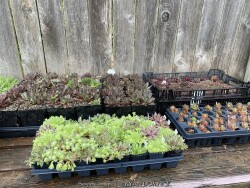

These tiny perennial succulents (Sempervivum sp.) produce various colored mats of foliage rosettes. In favorable conditions they can spread rapidly by offsets; several species are valued in cultivation as groundcover for dry, sunny locations. Hen & Chicks are native to alpine mountainous areas in native to southern Europe and northern Africa. Grow this small native gem in a rock garden, in cracks between rocks, or on top of or in a retaining wall. You may also grow in flat areas like in between stepping stones provided you used a gravelly or sandy base for the stones. It will not tolerate rich moist soils as other plants or weeds will shade it out. Crown rot can occur during lengthy hot humid summer rainy periods. Hen & Chicks do not thrive indoors; aphids and spider mites seem to find them after a few months but overwintering indoors in a cool environment may work. Plants with plenty of time to acclimate will thrive in full sun but be careful not to rush it or sunburning will occur. Generally if moving outside for the summer, allow 2-3 weeks of part shade or morning sun before placing in full sun. If grown in pots and kept on the dry side, you may leave out all winter allowing to freeze solid; plants will go dormant and resume growth in the spring. This is more successful than overwintering inside. Great low maintenance cold hardy succulent.
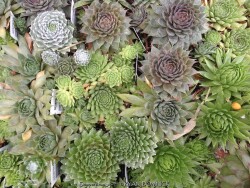

These tiny perennial succulents (Sempervivum sp.) produce various colored mats of foliage rosettes. In favorable conditions they can spread rapidly by offsets; several species are valued in cultivation as groundcover for dry, sunny locations. Hen & Chicks are native to alpine mountainous areas in native to southern Europe and northern Africa. Grow this small native gem in a rock garden, in cracks between rocks, or on top of or in a retaining wall. You may also grow in flat areas like in between stepping stones provided you used a gravelly or sandy base for the stones. It will not tolerate rich moist soils as other plants or weeds will shade it out. Crown rot can occur during lengthy hot humid summer rainy periods. Hen & Chicks do not thrive indoors; aphids and spider mites seem to find them after a few months but overwintering indoors in a cool environment may work. Plants with plenty of time to acclimate will thrive in full sun but be careful not to rush it or sunburning will occur. Generally if moving outside for the summer, allow 2-3 weeks of part shade or morning sun before placing in full sun. If grown in pots and kept on the dry side, you may leave out all winter allowing to freeze solid; plants will go dormant and resume growth in the spring. This is more successful than overwintering inside. Great low maintenance cold hardy succulent.
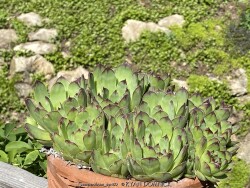

These tiny perennial succulents (Sempervivum sp.) produce various colored mats of foliage rosettes. In favorable conditions they can spread rapidly by offsets; several species are valued in cultivation as groundcover for dry, sunny locations. Hen & Chicks are native to alpine mountainous areas in native to southern Europe and northern Africa. Grow this small native gem in a rock garden, in cracks between rocks, or on top of or in a retaining wall. You may also grow in flat areas like in between stepping stones provided you used a gravelly or sandy base for the stones. It will not tolerate rich moist soils as other plants or weeds will shade it out. Crown rot can occur during lengthy hot humid summer rainy periods. Hen & Chicks do not thrive indoors; aphids and spider mites seem to find them after a few months but overwintering indoors in a cool environment may work. Plants with plenty of time to acclimate will thrive in full sun but be careful not to rush it or sunburning will occur. Generally if moving outside for the summer, allow 2-3 weeks of part shade or morning sun before placing in full sun. If grown in pots and kept on the dry side, you may leave out all winter allowing to freeze solid; plants will go dormant and resume growth in the spring. This is more successful than overwintering inside. Great low maintenance cold hardy succulent. Red-tip Green Hen & Chicks are among the largest, most reliable, and fastest growing.
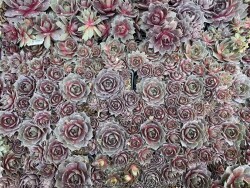

These tiny perennial succulents (Sempervivum sp.) produce various colored mats of foliage rosettes. In favorable conditions they can spread rapidly by offsets; several species are valued in cultivation as groundcover for dry, sunny locations. Hen & Chicks are native to alpine mountainous areas in native to southern Europe and northern Africa. Grow this small native gem in a rock garden, in cracks between rocks, or on top of or in a retaining wall. You may also grow in flat areas like in between stepping stones provided you used a gravelly or sandy base for the stones. It will not tolerate rich moist soils as other plants or weeds will shade it out. Crown rot can occur during lengthy hot humid summer rainy periods. Hen & Chicks do not thrive indoors; aphids and spider mites seem to find them after a few months but overwintering indoors in a cool environment may work. Plants with plenty of time to acclimate will thrive in full sun but be careful not to rush it or sunburning will occur. Generally if moving outside for the summer, allow 2-3 weeks of part shade or morning sun before placing in full sun. If grown in pots and kept on the dry side, you may leave out all winter allowing to freeze solid; plants will go dormant and resume growth in the spring. This is more successful than overwintering inside. Great low maintenance cold hardy succulent. Burgundy Hen & Chicks (Sempervivum tectorum) are brightly colored with new growth emerging bright purple darkening with age.


***Description for this perennial available with future update!*** >>>>>> This fall blooming aster does not splay open like other Asters can. According to Walters Gardens "Bringing refinement to fall blooming Asters, 'Grape Crush' produces a large, very round mound with densely packed flowers. We have observed no lodging in our trials, a phenomenal achievement for fall blooming Asters. Very rich, dark purple flowers are produced above dark green foliage in early fall to midfall. A perfect finale to the growing season!" Asters are native to North America and are generally very easy to grow.
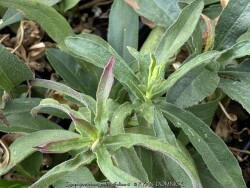

***Description for this perennial available with future update!***
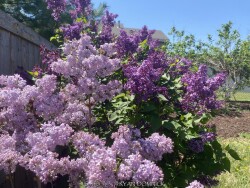

***Shrub descriptions available with future update!***>>>>>Ultra cold-hardy plants from northern climates normally dislike our long hot humid summers; although we are on the Southern edge of this plants adaptability, it still survives reasonably well here. Look for a cold microclimate planting location such as East or North exposure.>>>>>
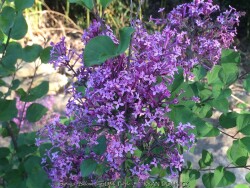

***Shrub descriptions available with future update!***Bloomerang Reblooming Dark Purple Lilac, is also known as Syringa x 'Bloomerang Dark Purple'
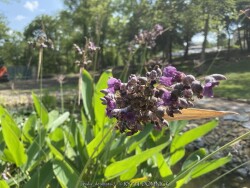

Thalia dealbata, commonly known as Hardy Water Canna, is a native water garden / marginal plant with tropical like foliage resembling that of a canna. This plant is usually grown as a bog plant needing constantly moist soil rich in organic matter. As a rain garden plant, it will thrive is a depressed area in the landscape that collects rain water from a roof during spring and summer periods of rain but then is amazingly drought tolerant if the water hole dries out. After extended drought, it will simply go dormant but not sure how long it will persist in this state. Flowers are purple and have been said to be carnivorous but in reality, small insects get trapped in the gummy gel-like substance around the flowers...larger polinators like bumble bees and carpenter bees can pull away after polination. There are no major or even minor pests: this plant will survive just about anything as long as the root ball doesn't freeze solid, hence the zone 6 designation by most sources. As far as winter hardiness, I would assume there is a requirement for being submerged in water or well mulched (or snow cover) if on dry land in sub freezing weather. A dry hard ground freeze can kill this plant even in warmer zones. In our Lawrence, Kansas display garden (zone 6a), this plant has thrived for many years with little effort.
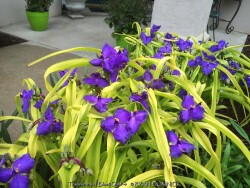

***Description for this perennial available with future update!***Blue & Gold Spiderwort, is also known as Tradescantia x andersoniana 'Blue and Gold'
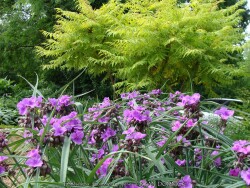

***Description for this perennial available with future update!***Concord Grape Spiderwort, is also known as Tradescantia x andersoniana 'Concord Grape'
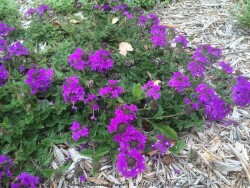

***Description for this plant available with future update!***


Narrow-leaf Ironweed (Vernonia lettermannii) is a relatively new plant to horticulture; originally discovered in Arkansas along gravel stream beds in the wild. The Iron Butterfly cultivar (Vernonia lettermannii 'Iron Butterfly') is a dwarf compact cultivar introduced by Dr. Allan Armitage at the University of Georgia. This is a true four-seasons perennial that belongs in almost every perennial garden. In the spring, narrow dark green foliage resembling Amsonia hubrichtii creates a compact shrub-like appearance. The growth is so dense that no weeds have a chance of invading a mature stand of plants. By mid to late summer, gorgeous deep purple fine-textured flowers cover the plant for 4-6 weeks. Butterflies, bees, and other pollinators flock to the occasion. Following the bloom, the flower stocks are sturdy and hold up very well for fall and winter interest. The flowers themselves produce mostly non-viable seed and cling to the plant creating a silvery shine whenever sunlight hits it. This can be very useful and dried flower arrangements as well as winter interest gardens. At some point in the winter, all top growth will need to be cut back as this is the only maintenance required. Despite being native to gravel and sand bars along rivers, Iron butterfly Vernonia surprisingly can handle very dry clay, gravelly, or sandy soils along with short periods of flooding. Permanently wet soil is not favored but it can handle the upper portions of a rain garden. Iron butterfly has only one pest problem and that is rabbits! If rabbits are an issue, just put a bowl-shaped chicken wire cage around the plants for the first year. By year #2, the rapidly growing foliage will outgrow any detrimental rabbit browsing. This is definitely one of the most adapted landscape plants in Kansas zone 6a with no problems with heat or cold, dry or wet! It's hard to imagine a perennial garden without this plant!
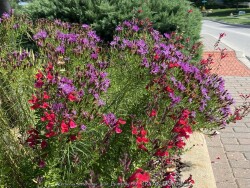

Narrow-leaf Ironweed (Vernonia lettermannii) is a relatively new plant to horticulture; originally discovered in Arkansas along gravel stream beds in the wild. The Iron Butterfly cultivar (Vernonia lettermannii 'Iron Butterfly') is a dwarf compact cultivar introduced by Dr. Allan Armitage at the University of Georgia. This is a true four-seasons perennial that belongs in almost every perennial garden. In the spring, narrow dark green foliage resembling Amsonia hubrichtii creates a compact shrub-like appearance. The growth is so dense that no weeds have a chance of invading a mature stand of plants. By mid to late summer, gorgeous deep purple fine-textured flowers cover the plant for 4-6 weeks. Butterflies, bees, and other pollinators flock to the occasion. Following the bloom, the flower stocks are sturdy and hold up very well for fall and winter interest. The flowers themselves produce mostly non-viable seed and cling to the plant creating a silvery shine whenever sunlight hits it. This can be very useful and dried flower arrangements as well as winter interest gardens. At some point in the winter, all top growth will need to be cut back as this is the only maintenance required. Despite being native to gravel and sand bars along rivers, Iron butterfly Vernonia surprisingly can handle very dry clay, gravelly, or sandy soils along with short periods of flooding. Permanently wet soil is not favored but it can handle the upper portions of a rain garden. Iron butterfly has only one pest problem and that is rabbits! If rabbits are an issue, just put a bowl-shaped chicken wire cage around the plants for the first year. By year #2, the rapidly growing foliage will outgrow any detrimental rabbit browsing. This is definitely one of the most adapted landscape plants in Kansas zone 6a with no problems with heat or cold, dry or wet! It's hard to imagine a perennial garden without this plant!
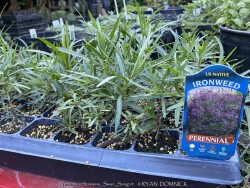

***Description for this perennial available with future update!*** >>>>> Narrow-leaf Ironweed (Vernonia lettermannii) is a relatively new plant to horticulture; originally discovered in Arkansas along gravel stream beds in the wild. The Iron Butterfly cultivar (Vernonia lettermannii 'Iron Butterfly') is a dwarf compact cultivar introduced by Dr. Allan Armitage at the University of Georgia. This is a true four-seasons perennial that belongs in almost every perennial garden. In the spring, narrow dark green foliage resembling Amsonia hubrichtii creates a compact shrub-like appearance. The growth is so dense that no weeds have a chance of invading a mature stand of plants. By mid to late summer, gorgeous deep purple fine-textured flowers cover the plant for 4-6 weeks. Butterflies, bees, and other pollinators flock to the occasion. Following the bloom, the flower stocks are sturdy and hold up very well for fall and winter interest. The flowers themselves produce mostly non-viable seed and cling to the plant creating a silvery shine whenever sunlight hits it. This can be very useful and dried flower arrangements as well as winter interest gardens. At some point in the winter, all top growth will need to be cut back as this is the only maintenance required. Despite being native to gravel and sand bars along rivers, Iron butterfly Vernonia surprisingly can handle very dry clay, gravelly, or sandy soils along with short periods of flooding. Permanently wet soil is not favored but it can handle the upper portions of a rain garden. Iron butterfly has only one pest problem and that is rabbits! If rabbits are an issue, just put a bowl-shaped chicken wire cage around the plants for the first year. By year #2, the rapidly growing foliage will outgrow any detrimental rabbit browsing. This is definitely one of the most adapted landscape plants in Kansas zone 6a with no problems with heat or cold, dry or wet! It's hard to imagine a perennial garden without this plant!
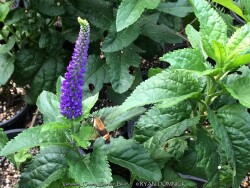

***Description for this perennial available with future update!***Sunny Border Blue Veronica, is also known as Veronica 'Sunny Border Blue'